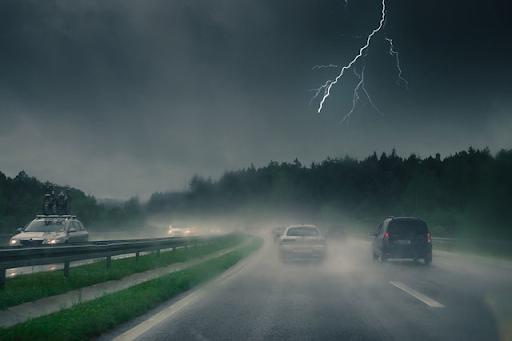Drivers who can avoid driving in storms should. However, sometimes life calls, even though the weather doesn’t cooperate. Driving in wet weather requires additional focus.
The Road Weather Management Program from the United States Department of Transportation, Federal Highway Administration compiled road weather variables that impact drivers.
For example, precipitation affects visibility distance, pavement friction, and lane obstructions. The conditions affect vehicle performance, driver behavior, traffic signal timing, and speed limits.
Thus, drivers must put themselves in the appropriate mindset to overcome the conditions.
Let’s look at how to drive safely during a storm.
Keep the Lights On
During storms, the clouds block the sun and reduce visibility. Therefore, to improve visibility, keep your headlights on. You might contend with other factors, such as heavy rain, high winds, and fog, but you must find ways to improve visibility.
Some car lights turn on automatically. Thus, it takes one thing off your plate. If your vehicle does not have this feature, flip them on.
Lights will improve your ability to see the road in front of you; lights also help other drivers. In heavy fog, front and rear lights alert others that a car is in front or behind them. It also helps them see the road.
Road accidents can occur without warning, especially during wet road conditions. Legal professionals can help guide impacted drivers. Contact them.
Slow Down
Drivers must adhere to the speed limit posted on roads and highways. The Department of Motor Vehicles and safety agencies expect drivers to slow down during heavy rainfall and high winds.
Traveling at the speed limit during heavy rainfall can cause vehicles to hydroplane. Therefore, accidents can scoop up more cars.
Avoid Tailgating
Most people who drive have a destination. Sometimes time catches up, and drivers have a higher sense of urgency.
Safety professionals encourage drivers to slow down their speed by one-third. Driving at 70 mph on the highway during storms is not recommended. Instead, slow down to 45 mph to 50 mph.
You’ll notice that some drivers drop their speed by half. Thus, they will cause congestion behind them.
Avoid becoming frustrated and tailgating. If you drive on another car’s bumper, you do not have enough time to stop. Safety professionals advise drivers to leave one car length for every 10 miles of speed in normal road conditions.
The amount of precipitation on the roads will impact your ability to arrive at a complete stop. Therefore, tailgating in the rain will cause more rear-end accidents.
Check the Wipers
Wipers cost between $20 to $40, depending on vehicle make and model. You can install them yourself or tip someone for the service.
Most drivers can change their vehicle’s wiper blades annually. Those who use them more often benefit from replacing them twice a year. You want to ensure they will wipe away raindrops, snowflakes, and hail.
Wipers help improve visibility. They can also help reduce the amount of fog on the windshield.
Focus on the Road
Once your car can handle inclement road conditions, you can focus on the road without distractions.
Driving already requires vigilance. During heavy rainfall, drivers must become more attentive. Avoid using electronic devices, talking with your passengers, or becoming frustrated with other drivers.
You might arrive at your destination later than anticipated. However, your priority is to arrive safely without impacting others.
Look Both Ways at Intersections
Storms impact driver visibility. Therefore, exercise extra caution before crossing intersections. The danger increases at yellow lights. Some drivers need to turn left and others intend to keep going straight.
If these drivers don’t consider each other, vehicle collisions can become more violent and have ripple effects. Road conditions become slippery from the rainfall. It’s also important to understand that water mixes with vehicle oil and fluids.
Therefore, vehicles might travel longer distances and spin out during an accident. Then, they can collect others.
Listen to the Radio for Updates
You can listen to the radio while driving. During inclement weather, consider listening to local stations that give weather updates. Local news radio stations will update listeners on the weather, accidents, and alerts from authorities.
If a roadblock to your destination exists, you’ll find out. Then, you can decide if you need to take a different route or turn around.
Conclusion
Millions of drivers safely arrive at their destinations in stormy weather daily. Drivers must adjust their behavior to prevent causing collisions. Since rain impacts visibility, ensure that your wipers will perform effectively. Then, avoid becoming frustrated with others who slow down way below the speed limit – put safety first.
Also Read: A Comprehensie Guide To Viking Arm Rings.

